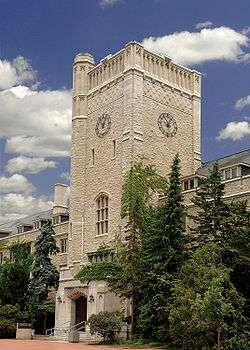Muck Crops Research Station
The Muck Crops Research Station is an agriculture research facility near Kettleby and Ansnorveldt, in Ontario, Canada. It is operated by the Office of Research at the University of Guelph.
The station's research[1] is focussed on several key areas:
- Crop protection of muck vegetables
- Evaluation of vegetable cultivars
- Post-harvest storage and treatment
- Soil and crop management
The station features greenhouses with a system-controlled environment, a plant pathology laboratory, and long-term cold storage. Seven hectares of land are split into plots devoted to researching organic and mineral soils. Local growers also participate in commercial field trials on occasion.[2]
Crop protection
Various long-term research projects analyze and assess the impact of indigenous and invasive pests and parasites. Since 1998, the site has studied the over-wintering ability of the pea leafminer[3] in southern Ontario, as well as associated parasitoid complexes collected from leafminer pupae.[4]
Protection from fungi and molds during storage is also studied at this station. For example, the mold Sclerotinia releases oxalic acid, a compound that allows the mold to infect carrots. Researchers are studying the use of "calcium formulations to deter Sclerotinia growth".[5]
Vegetable cultivars
One of the site's important functions is to determine the viability and suitability of specific crop cultivars in the Holland Marsh.[6] The area is a major producer of onions, carrots, lettuce, celery and Asian vegetables.[2]
Storage and treatment
The aim of research into storage of crops is to identify crops that may be grown in the Holland Marsh and stored for eventual winter distribution, so that residents of Ontario may have access to Ontario-grown vegetables year-round.
Onions, especially, and carrots go into long-term cold storage here," says McDonald. "So Ontario could supply the market year round and avoid importing from other countries.[5]
Soil and crop management
To improve yield and reduce the negative impact of agricultural practices on farmland, studies at this research station have attempted to identify conditions under which it is most appropriate to apply specific fertilizers. For example, nitrogen fertilizers are typically applied to carrot crops to improve yields and reduce leaf blight. Research at this station suggests that by matching the use of nitrogen fertilizers to the type of soil in which carrots are grown, high yields may be achieved. Moreover, this can be done with less nitrogen fertilizer and minimizing the use of fungicides to control leaf blight, decreasing costs and mitigating some environmental concerns.[7]
References
- "Kettleby/Bradford Muck Crops Research Tech Transfer Programs". Technology Transfer. Department of Plant Agriculture, University of Guelph. Archived from the original on 2003-10-18. Retrieved 2007-07-13.
- "Kettleby Research Station". Department of Plant Agriculture, University of Guelph. Archived from the original on 2012-07-17. Retrieved 2007-07-13.
- D. Martin; R. H. Hallett; M. K. Sears & M. R. McDonald. "Overwintering Ability of Liriomyza huidobrensis (Blanchard) (Diptera: Agromyzidae) in Southern Ontario, Canada". Environmental Entomology. Retrieved 2007-07-13.
- C. A. Bahlai; S. A. Goodfellow; D. E. Stanley-horn & R. H. Hallett. "Endoparasitoid Assemblage of the Pea Leafminer, Liriomyza huidobrensis (Diptera: Agromyzidae), in Southern Ontario". Environmental Entomology. Retrieved 2007-07-13.
- Boersma, Sigrid. "Mad about mucks". Cosmic Crops Research Magazine. Archived from the original on 2007-08-14. Retrieved 2007-07-13.
- "Where to Find Vegetable Variety Trial Information". Ontario Ministry of Food, Agriculture and Rural Affairs. Retrieved 2007-07-13.
- Sean Westerveld, Alan McKeown & Mary Ruth McDonald (Fall 2006). "Optimizing Nitrogen Fertilizer Application". Columbia Publishing. Retrieved 2008-02-15.
